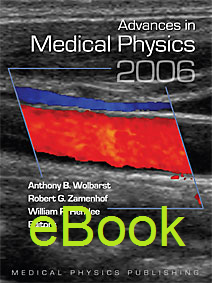
Advances in Medical Physics: 2006
Author: Anthony B. Wolbarst, Robert G. Zamenhof, and William R. HendeeISBN: 9781930524798
Published: 2006 | 376 pp. | eBook
Price: $ 80.00
Interactions | January 2007
This text is the first volume of a new biennial series “…intended to help practicing medical physicists, technically inclined physicians, and other interested professionals to stay current in medical radiation science and technology – and in particular in subfields of medical physics other than their own…”. Congruent with this goal is the well-written style, directed at the “…generalist in medical radiation science and technology, and a notch or two less rigorous than would satisfy the needs of a researcher in his or her own area…” (quotations from the preface), and the broad spectrum of its contents, ranging from various imaging related topics to the biological effects of radiation, radiation therapy and magnetic nerve stimulation.
The first six chapters of the book cover specific imaging modalities: digital radiography and fluoroscopy, mammography, CT, MRI, nuclear medicine and ultrasound imaging. Each gives an introduction into the field, and can easily be studied in small sections at a time, if the reader can not devote time for continuous study. Being the first in a whole series, this volume intentionally provides more scientific/technical background information, but also touches on advanced techniques, such as digital tomosynthesis or dual energy x-ray imaging, MRI perfusion imaging, PET/CT, SPECT/CT, and 4D ultrasound.
Chapters 7 through 9 take up additional imaging related subjects: a fine summary of the current efforts in molecular imaging is presented in chapter 7, featuring a side-by-side comparison of the diverse range of modalities employed. Other subsections are devoted to probes for molecular imaging, including nanoparticles, and current clinical and research findings. Chapter 8 contains an overview of medical imaging informatics and is structured into a section covering PACS and one about electronic medical records. Chapter 9 deals with evolving experimental technologies in medical imaging: it glances at such fascinating fields as terahertz and microwave imaging, thermography, mini and nanotechnology to name but a few; and though they obviously cannot be covered in great detail, it is an inspiring read and motivates additional study of select topics of interest.
The next two chapters are devoted to the interaction of ionizing radiation with biological tissue. Chapter 10 provides radiobiological background and concludes with a critical discussion of the linear non-threshold hypothesis of biological response to radiation. Radiation therapy is described in chapter 11, including sections about Tomotherapy, target localization techniques, 4-D radiation therapy and biological modeling. The volume concludes with a chapter about magnetic nerve stimulation, its history, implementation and clinical and research applications.
This text lives up to its goal of providing an outlook into the wide field of medical physics beyond the readers own area of specialization. The subject matter is presented in a clear, concise manner referring frequently to well-labeled illustrations. Mathematical formulation of the contents is almost entirely absent (the most notable exceptions being the chapters about MR and ultrasound), which makes the text easier to study but also decreases its depth and the reader will have to decide how far this trade-off is to his or her liking; numerous references in each chapter, however, provide useful jump-off points for more in-depth study. In future volumes of this series, one can look forward to more well-written reports from the frontiers of the advancing field of medical physics.


